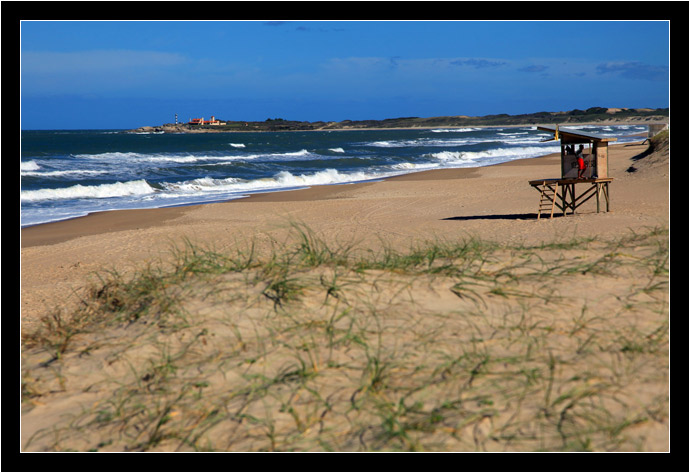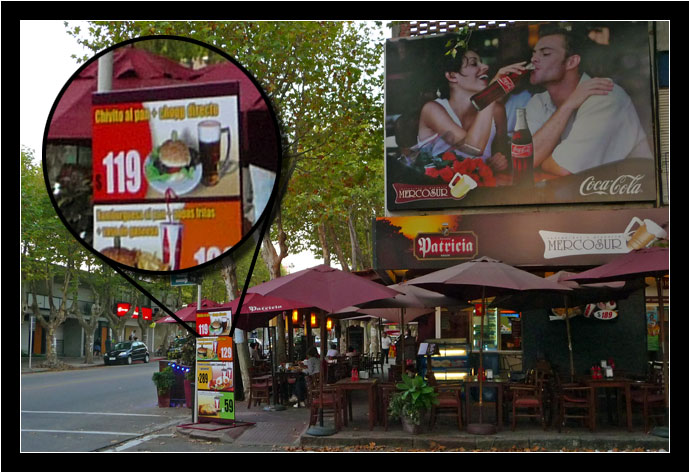
I want to make sure I do a “Thoughts on…” post for every country we visit, but I’ve fallen way behind. While traveling, I try to jot these things down as they occur to me, usually on my iPhone. I still have all my notes for every country, but I wrote down Uruguay’s way back in April. They’re not as fresh in my mind as they were back then.
Still, let’s try to catch up a bit:
Landscape
We only visited coastal areas in Uruguay – Montevideo, Punta del Este, Punta del Diablo, and Cabo Polonio – so I didn’t get to see much inland, but what I did see reminded me strongly of North Carolina.
Most of the roads between cites were two-lane blacktop and the view from the bus window was of nothing but flat farmland. On the red dirt roads to Cabo Polonio, the view was split between farms and groves of pine trees. Out on the highways, they even had the occasional John Deer dealership, complete with tractors and harvesting equipment lined up for display.
The beaches were uncannily like the Outer Banks, too. The same color sand, the same tall dunes, the same tall beach grass. I even spotted some sea fleas in the surf. Aside from the occasional penguin or sea lion carcass washed up on the shore and the rocky point, everything on the beach was so familiar that the first thing I did when I got back to civilization (i.e., internet access) was look up the latitude for Cabo Polonio. Sure enough, it was at almost the exact same level as Nags Nead, NC, just in the southern hemisphere instead of the north. Makes sense that things were so similar: Same position on the globe, same Atlantic Ocean joining them together.

Chivitos
One of the first things I noticed in Colonia, the first town we visited, were the advertisements on practically every restaurant’s sidewalk sandwich board. “Chivitos! Super cheap!”
(They didn’t actually say “super cheap.” I forgot what they actually said, but it was almost certainly in Spanish!)
On our first evening, after walking all over Colonia, we were famished at the nobody-ever-eats-this-early hour of 7pm. When we sat down at a sidewalk restaurant and tried to order, well, anything, the waitress would say, “That’s not available until we start up the grill.” When do you start up the grill? “9pm.”
So that first night we all ordered chivito. Turns out they’re simply thick-bunned, steak sandwiches with extras piled on top. Mayo, lettuce, tomatoes, maybe some guacamole, a fried egg. I ordered mine “Canadian style,” and got a slice of ham, to boot.

Giant Sandwiches
Browsing through the supermarkets, I noticed different varieties of sandwiches in the deli coolers. They had a few sub-style sandwiches, but what caught my eye were the flat ones made with square pieces of bread roughly the size of a soccer pitch. I remembered from my first visit to Argentina that they had similar sandwiches, only with the crust cut off. I guess if you were in the mood for four normal sandwiches, one of those goliaths would really hit the spot…
Mate Culture
Mate is the tea-like drink that Argentineans and Uruguayans drink with straws out of hollowed-out gourds. We thought it was popular in Argentina. Not compared to Uruguay!
Uruguayans carry their mate everywhere! On the streets, at the beach, in the buses… everywhere you look, people are cradling a thermos in the crook of their arm and sipping yerba from their cups.
It takes both hands to carry, serve, and drink your mate. To us ignorant foreigners, it just seemed so awkward to carry those two things around all day, but everyone does it. I think there’s a mint to be made for the person that creates the elegant-yet-stylish mate thermos harness!

Diet Cokes
Okay, this one was very minor, but…
Diet Cokes, in plastic bottles, must be super carbonated in Uruguay. When you twist the cap off the top, as soon as the gas can escape, it does so all at once. Instead of a hissssss coming out through the perforated ring that the cap’s attached to, it pops off loudly, releasing all the gas at once. More often than not, all those perforated spots on the safety-seal break at the same time, too. Startled me every time!
McDonald’s
Whenever you ordered a vanilla cone (or an Oreo cone!) at McDonald’s, it always came with a tiny little spoon. I always associated that type of ice cream spoon with “free samples,” so that you can try a flavor before paying for it, but at McDonald’s, where they only have two flavors, max, I can only imagine that a significant portion of the population likes to eat their ice cream cones that way. I guess it’d last longer…
Also, McDonald’s in Uruguay has the best name for a burger, ever. The “McBacon!” Who wouldn’t want to eat something like that (besides a Jew!)? Sadly, I realized after eating my first one, that it was nothing more than our own Bacon Double Cheeseburger with better marketing.

Alfajores
We were, of course, familiar with alfajores – those delicious layered cookies, dipped in chocolate – from our travels in Argentina. Like Argentina, it seemed as though each region (or city) in Uruguay had its own unique take on how to make the best alfajor.
I didn’t sample enough to choose a favorite, but I liked the way they packaged some of the boxes. If you were after six or more cookies, you could find them in boxes labeled with the city’s name and designed with a bunch of postcard-worthy photos on them. I flattened one from Punta del Diablo, packed it around, and later mailed it home as a souvenir!
Dumpsters and Recycling Booths
The first time we saw Montevideo, it was mostly from the window of our passing bus. We stopped at the station just long enough to transfer to another bus going to Punta del Este.
I did notice something new out the window, though. The streets of Montevideo seemed wide and spacious compared to other Latin American cities we’d been in. It was also remarkably clean, with very little of the trash lining the gutters of other places. It wasn’t long before I noticed one of the reasons why.
Montevideo was the first place I’d seen in South America that had actual dumpsters! Rather than those strange baskets of rebar for residents to balance their garbage in, they had the big enclosed bins just like businesses in the United States use. Not only do dumpsters mean that garbage is like likely to be scattered by the wind, cartoneros, or stray dogs, it also means that their whole garbage disposal service (with trucks that can lift the dumpster) must necessarily be more organized.
Once I knew what to look for, I also saw recycling stations on the corner of every other block, too. I have no idea if recycling has caught on and everyone takes it for granted, or if it was a new initiative struggling to break away from the cardboard recycling woes of Buenos Aires, but either way, I was happy to see Uruguay doing what it could to maintain an infrastructure that keeps its streets clean.
Books
Uruguay was the first country in Latin America where the books seemed to be set at reasonable prices. I didn’t do a direct price comparison with Argentina or anything, but I did notice that new and popular paperback thrillers were on the order of $8-10 USD instead of the $20-30 USD prices in other South American countries.
I wonder if Uruguay has a higher literacy rate. Or rather, even more interesting, if it has a higher number of college graduates. I wouldn’t be at all surprised to find out that something so simple as having lower prices on books would translate into statistics like that.
American Football
I was blown away – blown away! – to see a group of teenagers walking down the street of Montevideo wearing football pads and carrying their helmets. They’d obviously just finished with practice (or a game) and were leaving the field, and, just as obvious, their equipment could only be used for American football.
I know that Mexico has had an interest in American football for awhile now — The Dallas Cowboys are America’s Team and Mexico’s team – but I’ve never even heard of little league or high school teams in Mexico, let along Uruguay. Fútbol, as it’s known down there, is – was? – universally accepted to be soccer.
Seeing those boys walk by with their shoulder pads, cleats, and facemasked helmets, I wondered so many things. Is there a league? How many teams are there? Is there a professional/city league to aspire to after high school? Do they play teams in other countries? How does American football stack up in popularity to soccer?
Alas, I didn’t ask.
Finally, three more items were in my notes, but I’m not 100% certain why I wrote them down.
Check Splitting
We spent all of our time traveling in Uruguay with Wendy and Dusty, and part of our time with Stephen and Stephanie, too. I know we ate out at restaurants quite a few times with everyone, and I think I wrote down “check splitting,” because it surprised me how easily the waiters agreed to split the checks whenever we asked. Often times, in other countries, they’ll still split the check for you, but only after sighing, rolling their eyes, and saying, “I guess I can do that.”
Accent
I think I wrote this down because I noted that the Spanish accent used by Uruguayans was, to my ear, very similar to that used by the Porteños in Buenos Aires.
Eggs
I have no idea why I wrote down “eggs.” Pretty sure I wasn’t going to write about how they can go without refrigeration again (that was in my Thoughts on Argentina II post.) Did they package them a different way in Uruguay? Was it because they put them on everything, like steaks, as they do in Argentina? Could it be because we stayed with Wendy and Dusty and they noticed something about the eggs they eat for breakfast every single day of their lives? No idea.
This is why I need to keep on top of my “Thoughts on…” blog posts.

I had so much fun with you guys in Uruguay. Loved our asado in Punto del Este and the craziness that was Cabo Polonio. Can’t seem to remember anything special about eggs, aside from the fact that Wendy and I did in fact eat them most days (and still do!).
Strange thing, we have a friend going to Colonia in a couple of weeks and he declared to me today that he is going to try to recreate the picture of us jumping – stay tuned, we’ll see if he can pull it off. 🙂
Awesome! Tell your friend I can probably pinpoint the street on Google Maps if he wants. Wouldn’t it be hilarious if, in 10 years, it becomes a “thing.” Headline: Colonia Jumping goes viral!
Whoops – meant Punto del Diablo for the asado – never can really remember all those Puntos and Cabos, or really any city name in particular. 🙂
Funny…I read this post while eating breakfast…but alas, no eggs! 🙁 Let me tell you I really wanted them but I had to eat this naked tender wrap leftover from Buffalo Wild Wings. Missed the eggs.
I too don’t remember anything about special Uruguayan eggs. 🙁 I had fun in Uruguay with you two, though!